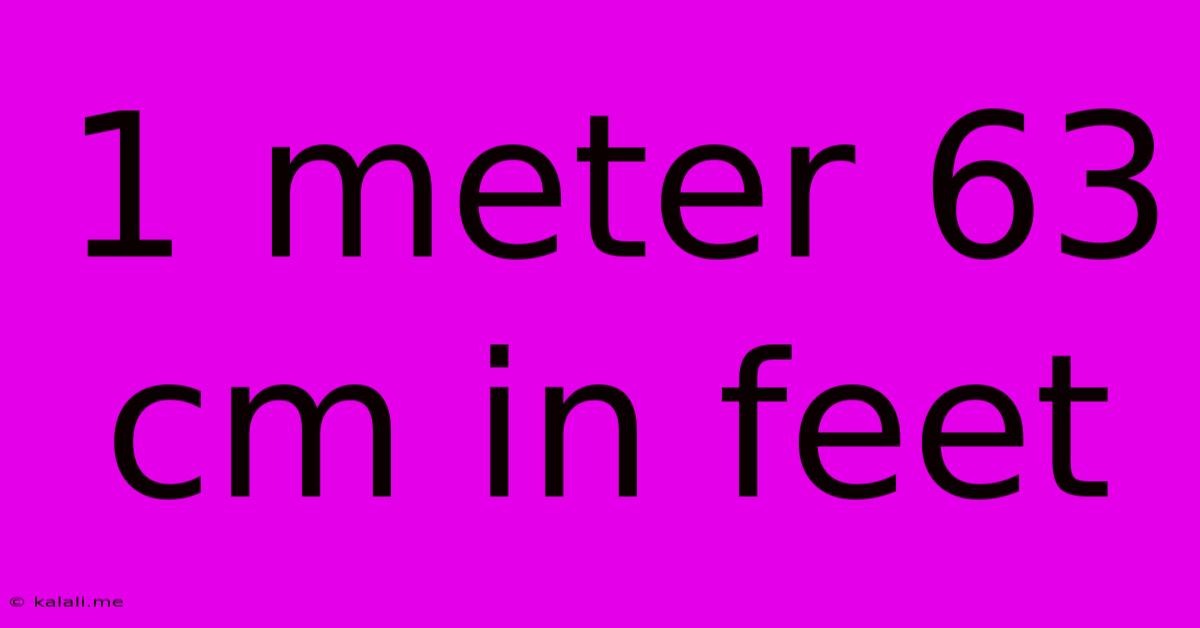1 Meter 63 Cm In Feet
Kalali
May 10, 2025 · 3 min read

Table of Contents
1 Meter 63 Centimeters in Feet: A Comprehensive Guide
Meta Description: Wondering how tall 1 meter 63 centimeters is in feet? This guide provides a precise conversion, explains the calculation, and offers helpful tips for future conversions. Learn how to easily convert metric measurements to imperial units.
Height conversions can be tricky, especially when dealing with metric and imperial units. Many people find themselves needing to convert measurements like 1 meter 63 centimeters into feet, perhaps for job applications, medical records, or simply satisfying their curiosity. This article will provide a clear and concise answer, explain the conversion process, and offer some helpful context.
Understanding the Conversion
The key to converting 1 meter 63 centimeters to feet lies in understanding the base units. One meter is equal to approximately 3.28 feet, and one centimeter is equal to 0.0328 feet. Therefore, we need to convert both the meter and centimeter components separately before adding them together.
First, let's convert the meter portion:
- 1 meter * 3.28 feet/meter = 3.28 feet
Next, we convert the centimeters:
- 63 centimeters * 0.0328 feet/centimeter = 2.07 feet (approximately)
Finally, we add the two converted values together:
- 3.28 feet + 2.07 feet = 5.35 feet (approximately)
Therefore, 1 meter 63 centimeters is approximately 5.35 feet.
Precision and Rounding
It's important to note that this conversion involves rounding. The actual conversion factor for meters to feet is slightly more complex, involving more decimal places. However, for most practical purposes, 5.35 feet provides a sufficiently accurate representation of 1 meter 63 centimeters.
Using Online Converters
For quicker conversions in the future, numerous online conversion tools are readily available. Simply search for "metric to imperial converter" or "centimeter to feet converter" and you'll find many options to help you easily convert various units of measurement. These tools often handle the calculations automatically, eliminating the need for manual conversions.
Beyond the Conversion: Understanding Metric and Imperial Systems
Understanding the differences between the metric (International System of Units or SI) and imperial systems of measurement is crucial for accurate conversions. The metric system is based on powers of 10, making conversions between units relatively straightforward. The imperial system, on the other hand, uses a less consistent system of units, making conversions often more complex and requiring specific conversion factors.
Practical Applications of Height Conversions
Knowing how to convert heights is useful in various situations, including:
- International Job Applications: Many job applications, particularly in international companies, require height specifications in either metric or imperial units.
- Medical Records: Medical professionals might use either system depending on the location and patient's preferences.
- Clothing Sizes: While clothing sizes often have their own systems, height can be a useful factor when ordering clothes online, particularly from international retailers.
- Sports: Height is an important factor in many sports, and conversions might be necessary when comparing athletes from different countries.
By understanding the conversion process and utilizing available tools, you can confidently navigate between metric and imperial units, ensuring accuracy in your measurements and comparisons. Remember, while online converters are convenient, understanding the underlying principles ensures a more comprehensive understanding of units and measurements.
Latest Posts
Latest Posts
-
How Much Is 10 Miles In Minutes
Jul 18, 2025
-
How Much Is 48 Oz Of Water
Jul 18, 2025
-
How Long Does It Take To Drive 2000 Miles
Jul 18, 2025
-
How Many Grams In A Teaspoon Of Cinnamon
Jul 18, 2025
-
How Long To Heat Water In Microwave
Jul 18, 2025
Related Post
Thank you for visiting our website which covers about 1 Meter 63 Cm In Feet . We hope the information provided has been useful to you. Feel free to contact us if you have any questions or need further assistance. See you next time and don't miss to bookmark.